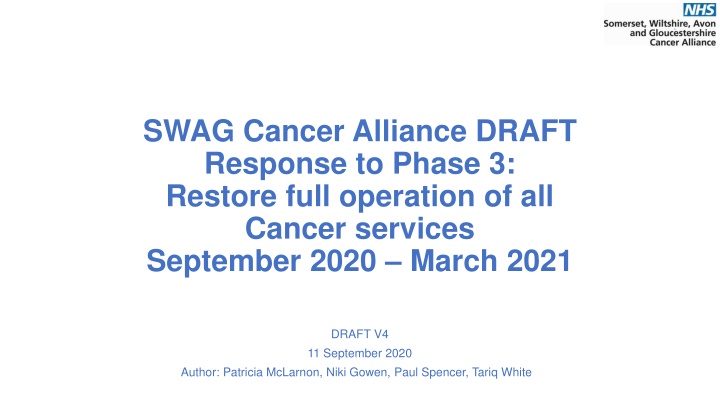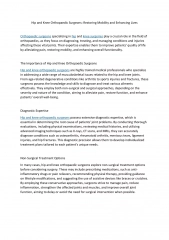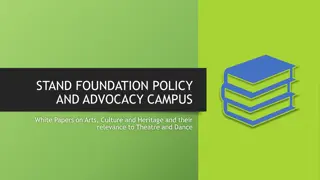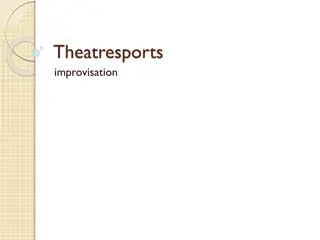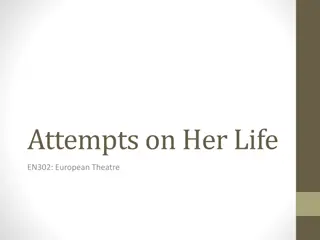Teaching in Operation Theatre with Dr. Biju Ravindran - Orthopaedics Prof
Dive into the world of surgical education with Dr. Biju Ravindran, a renowned Orthopaedics Professor, as he shares insights on pre-operation theatre teaching, maintaining sterility, surgical procedures, and post-operative protocols. Explore the nuances of teaching in pandemic situations, including online and offline modes, small group sessions, and real-time video streaming. Discover innovative tools like 3D printed cameras for enhanced learning experiences in the operating room.
Download Presentation

Please find below an Image/Link to download the presentation.
The content on the website is provided AS IS for your information and personal use only. It may not be sold, licensed, or shared on other websites without obtaining consent from the author.If you encounter any issues during the download, it is possible that the publisher has removed the file from their server.
You are allowed to download the files provided on this website for personal or commercial use, subject to the condition that they are used lawfully. All files are the property of their respective owners.
The content on the website is provided AS IS for your information and personal use only. It may not be sold, licensed, or shared on other websites without obtaining consent from the author.
E N D
Presentation Transcript
SWAG Cancer Alliance DRAFT Response to Phase 3: Restore full operation of all Cancer services September 2020 March 2021 DRAFT V4 11 September 2020 Author: Patricia McLarnon, Niki Gowen, Paul Spencer, Tariq White
Recovery Aims The overall aims of the cancer recovery phase are to: 1. Restore urgent cancer referrals to pre-pandemic levels 2. Reduce the backlog at least to pre-pandemic levels on 62-day (urgent referral and referral from screening) and 31-day pathways 3. Ensure sufficient capacity to manage increased demand moving forwards including follow up care Supporting objectives A. To support recovery with Alliance working through and with systems B. To tackle inequalities, including where they may have been further impacted by the COVID-19 pandemic C. To ensure that patients and staff have confidence that services are COVID-protected E. To ensure we have the right workforce in place F. To re-start Long Term Plan activity which supports recovery D. To lock in innovations prompted by the pandemic or which support recovery G. To ensure effective communications across the wider cancer community
1. Restore urgent cancer referrals to pre-pandemic levels Analytical Approach to Identifying the Missing Referrals - SWAG Weekly Cancer Recovery Pack at provider and tumour site specific to monitor referrals rates and action, identify unmet hidden demand and project recovery trajectory and action appropriately, implement local approaches to increase referral levels, putting in place specific actions to support any groups of patients who might have unequal access - SWAG Lung cancer plan Sept Dec 2020. Support to Primary Care - series of Alliance/system led webinars with primary care education for specific tumour types and generally to promote early referral and diagnosis, continue analytical support for referral management and early diagnosis via PCN Early Diagnosis Data packs, Support primary care to restore activity to usual levels where clinically appropriate, and reach out proactively to clinically vulnerable patients and those whose care may have been delayed i.e. lung, LGI, procurement of primary care digital cancer support tool to enable early identification, best practice referral management, safety netting, risk stratification and business information - delay due to COVID, consider Cancer Alliance Primary Care Clinical Leadership Work alongside NHSE/I public health commissioning teams as they restore screening services - proposal to develop a pro- active cancer screening video to reassure patients to attend, one of many initiatives. Building Public Confidence continue to support national/regional public awareness campaigns, amplified with tailored local messaging via SWAG Clinicians and patient-led talking heads videos for widespread dissemination to help support public and patient confidence to attend primary care and then as required attend secondary care for diagnostics. Continue to follow good COVID-related practice by application of PHE s IPC guidance to enable patients to access services safely and protect staff.
2. Reduce the backlog at least to pre-pandemic levels on 62-day (urgent referral and referral from screening) and 31-day pathways Key Actions: SWAG System Oversight Established Clinical Prioritisation Group (CPG), virtual mutual aid hub agreed with SOP in place for surgery, extending cancer hub mutual aid approach to all treatment modalities and diagnostics Trusts continue to maintain robust patient tracking lists/safety netting within secondary care Trusts continue prioritising longest waiters in line with clinical priority CPG weekly review of providers SITREP (report >104d, >62d, >31d) early warning system to operationalise mutual aid SITREP reports also trust pressures in diagnostics, surgery, chemotherapy and radiotherapy, theatre and critical care capacity and other issues including staffing constraints and IT support. Continue to revise existing clinical pathways where appropriate e.g. FIT in LGI CPG oversight of long waiters by tumour site and provider, audit of 104-day Patient Choice, Upper and Lower GI, by tumour site breakdown WDDT and WODDT, with provider specific improvement plans requested where cause for concern, track progress and implement any resulting action Implement key interventions from Endoscopy, CT/MRI and Cancer Adopt & Adapt Plans Trusts and system supporting the delivery of relevant Adopt and Adapt endoscopy and CT/MRI diagnostics interventions and treatment so far as the provision of required funding permits; Accelerate the development of RDSs, implementation and delivery for Non site specific and site specific suspected cancers as defined in the RDC plan, recover the priority rapid diagnostic pathways to pre pandemic levels, and support going further
3. Ensure sufficient capacity to manage increased demand moving forwards including follow up care Maximise use of available capacity through system wide working CPG oversight mutual aid hub agreed with SOP in place for surgery, extending cancer hub mutual aid approach to all treatment modalities and diagnostics Continue to follow good COVID-related practice to provide services safely, protect staff, and improve productivity Prioritise implementation of actions from Adapt and Adopt cancer workstream on optimising productivity and capacity for treatment Consider development of Community Diagnostic Hubs (Bristol Nightingale) and Rapid Diagnostic Centres (as more information emerges) Support and enable wider approaches aimed at maximising available capacity, e.g. development of diagnostic networks, image sharing and networked reporting Maximise Use of NHS and Independent Sector Providers IS capacity will continue to make an important ongoing contribution to protecting cancer treatment during the Phase 3 period as operational plans are progressed to manage COVID surges and winter pressures. Support recovery of PC&S - delivery of personalised stratified follow up (PSFU) and personalised care interventions will support recovery through freeing up outpatient appointment capacity. Implement FIT prior to LGI 2ww referrals, c50% reduction in LGI referrals. Implement teledermatology pre-2ww referral (Leeds model) which from pilot phase shows c50% reduction in skin cancer referrals required.
SWAG Lung Recovery Plan referrals 55% from baseline Alliance Objectives Recover DA CXR numbers to pre-covid baseline pre winter pressures Recover eRS (or internal) 2ww booking / referral numbers to baseline pre winter pressures Prevent increase in ED lung cancer diagnosis during winter 2020/21 Recover the baseline number of patients escalated to CT within 72 hours All providers D/C post normal CT without appointment All providers to adopt NHS Lung cancer treatment algorithms and request defined test bundles at 1st OPA Ensure curative treatments return to pre-covid baseline levels pre December 2020 Apply the Rapid Diagnostic Centre principles to suspected lung cancer pathways at all providers Action Plan to Implement: Preparation; Complete Describe current DA CXR and eRS 2ww lung bookings comparative to baseline and project recovery trajectory with and without intervention Describe recovery trajectory with and without intervention for diagnostics, appointments, diagnosed cancers and treatments Identify STPs with slower recovery trajectories for increased support Strand 1 Lung Cancer Specific SW regional version of NHS England and NHS Improvement national Help us to help you campaign Strand 2 STP lung referral recovery plans to include; GP Support Identification and plan to address access inequalities Direct Access Diagnostics Imaging adopt and adapt plans NOLCP pathway innovations NOLCP pathway improvements Curative Intent Management Pathway Rapid Diagnostic Centre principles applied to suspected lung cancer pathway including adoption of Rapid Diagnostic Lung Cancer Timed Pathway Strand 3 CA programme of PCN DES Early Diagnosis support Strand 4 Rapid Diagnostic Centre (Lung cancer service) principles described and funding made available for adoption across all lung cancer services
Rapid Diagnostic Service Plan (2020/21 Recovery) Non site specific pilot programme: National requirement 2020/21 SWAG population coverage 40% Continue resumption of Devizes and Mendip PCN NSS RDS pilots Realise delivery of proposed BNSSG NSS RDS Pathway Business Plan development of paused Minerva PCN and Keynsham PCN NSS pilot proposals Receive Business Plan pilot proposals from Somerset and Gloucestershire STPs Receive STP plans for Site specific tumour pathway transformation of lung, colorectal, prostate, UGI and other pathways, most likely to support local cancer service recovery, addressing; Early identification and timely referral of patients at risk through public health awareness and improved support for primary care Coordinated testing: Embed ring fenced bundled cancer diagnostics and encourage patient pathway engagement with cold site reduced hospital visits Timely diagnosis: Reduce numbers of long waiters who are yet to have a decision to treat Onward referral of non malignant conditions
Personalised Care and Support Delivery of personalised stratified follow up (PSFU) and personalised care interventions will support recovery through freeing up outpatient appointment capacity. All SWAG trusts are on target to provide PCS interventions for breast, prostate and colorectal patients to pre-pandemic levels. Personalised Care & Support Plans (previously HNA s) - via telephone or a virtual platform. FTF is offered at some hospital sites for specific communication needs where appropriate and safe. FTF activity projected to pick up 2021 when appropriate and safe Health & Wellbeing Events, Information & Support Telephone support with information posted and patients, signposting to trust websites for recorded events. Virtual live events widely offered though uptake often minimal. Recorded events better uptake & further work is underway in all trusts to provide this. Plan to re-initiate patient groups when safe, but retain video resources for patients who may not be able to attend. FTF planned in many trusts for 2021 for those with limited digital access. End of Treatment Summaries Three trusts have these established in the three cancer types. The remaining trusts are completing work to meet this target on schedule. What next: Re - establish PCS steering group in line with SWAG new governance structure reinstate clinical leadership, resolve commissioning of PC&S services to ensure sustainability and scaling up to ensure all other cancer types rapidly follow (April 2022 at the latest). Keep what's working well virtually and develop further recognising that some interventions do not always suit all patients e.g. breaking bad news. PSFU - By April 2021, all trusts to have clinically agreed personalised stratified follow up protocols in operation for colorectal and prostate cancer. Implementation of digital RMS should follow as soon as possible (April 2022 at the latest) Cancer Alliances can plan to roll out Personalised Stratified Follow Up (PSFU) to other cancer types from this year, with a view to having in place at least five cancer types by 2023/24. This is in addition to the existing requirement for PSFU for breast, prostate and colorectal - All SWAG clinical teams are considering which patients groups could be suitable for supported self-managed follow-up rather than face-to-face or virtual. Learning from the national evaluation of PSFU will support this. Current developments include the planned roll out of lymphoma and gynae (UHBW exemplar) across all providers in SWAG. Bladder being tested at NBT to later implement across SWAG. Skin PSFU in development across SWAG. The Cancer Quality of Life (QoL) Survey will be live from September 2020. A central comms pack is available and Cancer Alliances LWBC Leads should use this to help promote the survey across their Alliance - SWAG have actively engaged with the QoL survey team and are part of the phase 5 steering group. A SWAG-wide information event was held on 18-9-20 to raise awareness & promote patient uptake. Engagement will continue in both these areas. Work is underway to understand the data that will be produced and how this can be used for improving patient outcomes in follow-up appointments as well as wider service improvements'.
Plan on a page Aims Supporting objectives Work through PCNs to ensure best practice referral management and drive forward the DES ED ambitions Aim 1: To restore urgent cancer referrals at least to pre- pandemic levels Alliance will continue to work through and with systems in an integrated way A. To support recovery with Alliance working through and with systems Ensure effective partnerships and communication between primary and secondary care services to promote efficient referral pathways and a positive patient experience, with clear understanding of how services are operating during recovery Maintain oversight of a single dataset at national, regional and local system level on referrals, treatment and backlog numbers Monitor referral and treatment metrics by deprivation or ethnicity as data permits B. To tackle inequalities, including where they may have been further impacted by the COVID- 19 pandemic Build staff and patient confidence around services Amplify national/regional public awareness campaigns Support public and regional awareness campaigns in line with data Implement local approaches to increase referral levels, putting in place specific actions to support any groups of patients who might have unequal access Promote implementation of national guidance on maintaining COVID protected environments, including use of PPE and testing of staff and patients C. To ensure that patients and staff have confidence that services are COVID-protected Work alongside NHSE/I public health commissioning teams as they restore screening services Communications with patients on steps being taken to ensure safety Aim 2: To reduce the backlog at least to pre- pandemic levels on 62 day (urgent referral and referral from screening) and 31 day pathways Prioritise patients most at risk and ensure clinical harm reviews are undertaken as per current guidance Consolidate the hub mutual aid model - ambition is that this will be a springboard going forward to avoid cancelling cancer surgeries D. To lock in innovations prompted by the pandemic or which support recovery Audit of 104 waiter s day and take appropriate action Embed Rapid Diagnostic principles in patient pathways Support an immediate increase to endoscopy and imaging capacity through the Adapt and Adopt (A&A) approach Adapt referral pathways to reflect COVID-19 Utilise updated clinical triaging guidance for patients with LGI symptoms in primary and secondary care Support returners and volunteers to help cancer recovery E. To ensure we have the right workforce in place Support the alignment of IPC controls locally to increase productivity Work towards reducing gaps in workforce and support existing staff to continue to deliver care Prioritise cancer recovery A&A for treatment Aim 3: To ensure sufficient capacity to manage increased demand moving forward including follow-up care Training bursaries for CNSs and chemo nurses Consider hub model, use of system PTL to diagnostics/other treatment as appropriate to maximise efficiency of capacity Prioritise LTP commitments that will support recovery, including RDSs and PSFU - see slides 7 and 8 for detail F. To re-start Long Term Plan activity which supports recovery Maximise the use of IS Continue to host weekly Clinical Leads calls, biweekly system response calls G. To ensure effective communications across the wider cancer community Ensure follow up services such as PSFU are resumed and have appropriate capacity to meet any increases in service use
Risks against delivery of Phase three plan Risk Factor Planned mitigation CA Funds 20/21 Discussions with regional finance colleagues' and BNNSG finance leads
